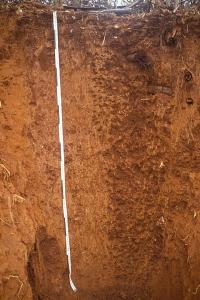Reference soil Kenya 51: Lixisol
Lixisols occur dominantly in the drier parts of the tropics and subtropics. Their high base status is partly due to less leaching, partly to admixture from airborne dust from adjacent desert regions.
Characteristics
Soils having an argic horizon (a subsurface horizon with a distinct higher clay content than the overlying horizon), which has a cation exchange capacity of less than 24 cmolc per kg in some part, either starting within either: 100 cm from the soil surface, or 200 cm from the soil surface if the argic horizon is overlain by loamy sand or coarser textures throughout. They have a base saturation (total amount of Ca, Mg, K and Na with respect to the cation exchange capacity) of 50 percent or more in the major part between 25 and 100 cm from the soil surface.
Reference soil KE051: Lixisols
Brief soil description: Very deep, well drained soil derived from gneiss; with a very thin, dark red sandy clay topsoil over a dark red, sandy clay subsoil which is very gravelly between 10 to 25 cm depth. Thin clay cutans occur in all horizons. The soil is under acacia bushland which is browsed by cattle. Parent rock: hornblende biotite gneiss. A tor lies 50 m from the soilpit. Tors and earthpyramids are found on many places and mark the severe erosion in this area. Slides: 10,092 - 10,105
